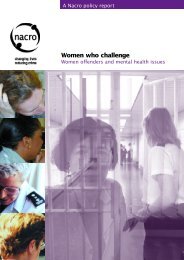Youth Crime briefing - Nacro
Youth Crime briefing - Nacro
Youth Crime briefing - Nacro
- No tags were found...
You also want an ePaper? Increase the reach of your titles
YUMPU automatically turns print PDFs into web optimized ePapers that Google loves.
Some facts about children and young people who offend – 2004warning or conviction by offence type, for the years1993, 2003 and 2004. Other than those categoriesalready discussed, the major point of significance is alarge increase in drugs offences since the early 1990s,most of which involve possession of cannabis, now aClass C drug. Since the figures exclude summaryoffences, the picture displayed somewhat overstatesthe general gravity of youth offending. (Weresummary offences included, for instance, robberywould constitute less than 2% of recorded crime.)But if a focus on serious youth offending tends toobscure the general nature of the majority of crimecommitted by young people, it also detracts attentionfrom the fact that the large preponderance of seriousoffences are committed by adults. During 2004,persons over the age of 18 years were responsible formore than three and a half times as many violentoffences and more than six times as many sexualoffences as children and young people. Robbery isfrequently portrayed as a ‘young person’s offence’,but even here, adults accounted for 57% of the total.The characteristics of children andyoung people who offendRiskAn increasing number of research studies suggest thatit is possible to identify some of the factors whichtend to be associated with offending, particularly forthose young people whose offending is serious orpersistent. These ‘risk factors’ as they have come tobe known, are familiar to most of those workingwithin the youth justice system and include:• Inadequate or inconsistent parenting• Disaffection with school or low educationalachievement• Substance or alcohol misuse• Mental ill health. 21Gang membership too is correlated with an increasedrisk of offending and the strength of the relationshipappears to increase with age up to the late teens,before declining again. In one study for instance, thevolume of self reported delinquency among gangmembers aged 17 years was 6.42 times as high asamong those who did not consider themselves tohang around in a gang. Moreover, changes in levels ofdelinquency among individual young people werealso closely linked to whether or not they were in agang at that particular point in time. 22Recent research also suggests that experiences ofbereavement and loss, which it has long beenrecognised may be correlated with serious or gravecrimes, may, in addition, be more common amongyoung people whose offending is at a lower level ofseriousness than has previously been acknowledged. 23But the ‘risk factor paradigm’, as it has been termed,should not be thought of as providing astraightforward causal account of the origin of youthoffending, which allows prediction from anaccumulation of characteristics to later criminalbehaviour. Armstrong has recently pointed out, forinstance, that the majority of young people whooffend do not in fact belong to what might beconsidered the high risk group. Conversely, whilemany children in trouble have a disruptedbackground, the majority with such problems do notgo on to become offenders. 24 Inevitably the picture israther more complex than is sometimes suggested.For instance, while there is clear relationship betweensubstance misuse and crime, that relationshipoperates in a variety of ways, frequently mediated byother factors. According to the Offending, <strong>Crime</strong> andJustice Survey (OCJS), for instance, young people whoreported using any drug within the past year werealmost twice as likely to admit having committed anoffence as those who did not, while those who hadused Class A drugs were three times as likely to beclassified as ‘serious’ or ‘frequent offenders’. 25 At thesame time, as another study has shown, onset foroffending is 14.5 years compared with 16.2 years fordrugs generally and 19.9 years for hard drugs. <strong>Crime</strong>tends to precede drug use rather than vice versa. 26Moreover, substance misuse is heightened amongyoung people considered to be vulnerable (defined asever having been in care, ever having been homeless,truanting, excluded from school or a serious orfrequent offender), suggesting that the relationshipbetween drugs and offending is not a linear one.VictimisationThe OCJS illuminates a further characteristic typicalof young people in trouble with the law. Teenagershave a significantly higher risk of victimisation thanadults 27 but the chances of being a victim are notevenly distributed within the younger age group.Thus while just over a third of 10 – 15 year olds hadbeen a victim of a personal crime in the past year,those whose carers were perceived to have poorparenting skills, those who had been excluded fromschool, and those who had friends or siblings whowere in trouble with the police, had significantlyhigher rates of victimisation. 28 It appears then that therisk factors for victimisation closely mirror those foroffending. The striking overlap is easily explainedsince, for that age group, 52% of those who admittedoffending had also been victims, compared with lessthan a quarter of non-offenders. These findingsreflect earlier research that suggests a complexinteraction between offending and victimisation so faras children and young people are concerned.‘Victimisation predicts delinquency three years later;and also delinquency predicts victimisation three yearslater. The more often victimisation is repeated, themore strongly it predicts delinquency’. 29There are, at the same time, geographic variations interms of risk. The chances of being a victim ofpersonal theft, for instance, among thosecommunities classified as ‘hard pressed’ are 50%higher than in areas occupied by ‘wealthy achievers’. 30The risk of being burgled is 237% greater. Youngpeople who come from the most disadvantagedneighbourhoods are thus most at risk of victimisationand of engaging in offending behaviour.Rather than anticipating a causal relationship betweenrisk factors and delinquency, it is accordingly morehelpful to understand the correlations as reflectingthe substantial commonality of the circumstances thatgive rise to both. This helps to explain why levels ofpage
















